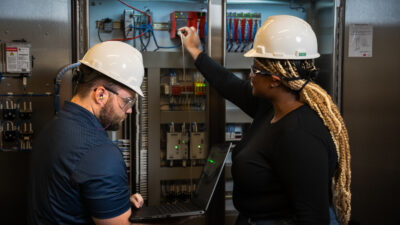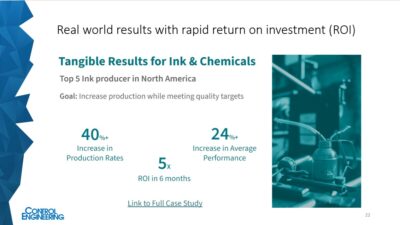AutomationNTH is the 2020 System Integrator of the Year for the Small System Integrator Category. Jeff Buck, vice president of engineering at Automationnth, shares some of the company's success stories and advice. See video.

Automationnth has earned a seat at the table. It’s a small system integrator (by category) with a global reach. Jeff Buck, vice president of engineering at Automationnth, spoke with CFE Media about its success and its client relationships:
CFE Media: Congratulations on receiving the 2020 System Integrator of the Year award. Talk about what this kind of recognition means to you and your team.
Jeff Buck: Being selected as the 2020 System Integrator of the Year is very exciting for both me personally as well as our entire team at Automationnth. I joined Automationnth in 2003 as employee number five and to see our growth over the past 16 years has been very fulfilling as we strive to serve our customers by providing “excellence in automation.” To win this award as we celebrate 20 years of service is validation for all the hard work by the entire the Automationnth team.
CFE Media: What do customers most request as a project begins? What are the keys for a successful project launch?
Buck: Fundamentally, all customers request the assurance that their project will be successful. How this comes to be varies dramatically depending on the customer. We have some customers where the project begins with a request for quote (RFQ) and their only request is that you satisfy the RFQ as cost effectively as possible.
Our preference, however, is to engage with the customer in the earlier phases of the project where they still are defining the requirements for the project where we can provide guidance on risk mitigation and help scope the project in collaboration with the customer to provide the most robust end solution. This allows us to act as the controls and automation experts, or “architect of automation,” while collaborating with our customers as they are the product experts.
With this approach, the customer is fundamentally requesting guidance to help bring their automation project to “safe harbor” under the guidance and direction of a qualified automation “harbor master.” By working together and building on the strengths of each, we often focus our initial efforts on risk mitigation by supporting proof of principle or prototype development to validate a proposed solution before a larger capital investment is made for the production system. This has proven to be very successful for our customers.
The keys to a successful project launch are to look beyond the written specifications, RFQ and other provided documentation to fully understand what will make the customer successful and meet their goals and objectives. Then we as a system integrator need to work in the best interest of our customer to execute the plan to deliver a successful project.
Jeff Buck, vice president of engineering at Automationnth. Courtesy: Katie Spain, CFE Media and Technology
CFE Media: Talk about project management as a strategy for Automationnth. Why is it important, and how does this help end users achieve their goals?
Buck: As the saying goes, “Failing to plan is planning to fail.” This is most certainly true as automation success stories don’t just happen by accident. They are instead the result of purposeful attention to details, requirements, schedule, resourcing needs and project execution. The project manager is the key orchestrator to make sure all these things happen on time and on budget. The project manager also helps manage conflict and sets expectations appropriately with the customer.
Project management is especially important to us because of our certified automation partner (CAP) program where we may manage a mechanical partner. To ensure we consistently deliver projects with excellence, we have developed our “NTH Process Manual” that documents our project management methodology and the required “check points” throughout the project. This project management strategy sets in motion the key action items that must take place for our “process” to work for our customers.
CFE Media: How does the Automationnth Certified Automation Partner program work? What are the benefits to your customers?
Buck: The CAP program has been a game changer for Automationnth and our customers. We created this program because purchasing automation equipment is challenging. Automation is very complex and technical. Choosing the wrong supplier can be disastrous. For that reason, we qualify automation companies through a rigorous assessment using our knowledge of automation industry best practices. If the automation company qualifies, they become a CAP.
The CAP program enables Automationnth to work with manufacturers to recommend specific partners for a project based on their fit with the application’s requirements.
If it is appropriate, Automationnth can provide turnkey automation by pairing our controls engineering and project management expertise with the mechanical capabilities of a certified partner. Depending on the situation, we can either be the prime or a sub to a certified partner.
The CAP program benefits manufacturers because Automationnth can reduce supplier risk. If we lead the controls engineering, our customer can have consistent controls architecture and IIoT capabilities across multiple automation systems, regardless of which supplier builds the machine or the scale of the system.
As such, this has been a win-win-win. Our customers win by partnering with an industry leader that is focused on controls and system integration, our mechanical partners win by expanding their footprint beyond their normal customers and Automationnth wins by being able to expand the reach of our controls and integration capabilities.
Our customers have seen a tremendous value in this CAP certification process and have asked us to validate potential CAPs even when Automationnth has no involvement in the project. This gives our customer the confidence to move forward with that CAP.
CFE Media: What do customers want to accomplish with the Industrial Internet of Things (IIoT)? How do you assess their IIoT maturity, and how can you help them toward a successful implementation?
Buck: The companies we have seen that are most actively pursuing the Industrial Internet of Things (IIoT) are those where “data” is seen as a key tool to optimize their manufacturing. As an example, we have seen that medical device manufacturers are interested in IIoT and how to use this data for improving yield loss, for measuring and optimizing for critical to quality metrics, and for a reduction in downtime through predictive analytics.
Assessing the IIoT maturity of our customers can be challenging and requires conversations to assess their openness to connectivity, machine performance analysis, prediction and simulation. Fundamentally, the concept of data collection has been around for a long time. Those customers who are already collecting as much data as they can and are using that for statistical process control (SPC) improvements are those who are most ready to embrace IIoT and its implementation.
CFE Media: How are you working with your clients to move forward in their journey toward digital transformation? How engaged are they on this journey?
Buck: Our efforts in digital transformation are focused in four areas: connectivity, machine performance analysis, prediction and simulation.
First, to enable other digital transformation capabilities, we work with our customers to create a fully connected system that provides the backbone for data flow from the plant floor to the enterprise level within an organization. We are doing this in a practical way by using Ethernet communication across the machine layer plus using IO-Link technology at the sensor level. We also can bring manufacturing data securely into the cloud for cross-plant storage and analysis.
To analyze machine performance, we developed a software module called OEE Optimizer on the ThingWorx platform. OEE Optimizer provides insight into yield loss, fault conditions and uptime, and helps our customers focus their efforts on areas that will have the biggest impact on system performance.
We also are developing tools using ThingWorx to predict rejects, faults or hardware failure before it happens.
Finally, we use simulation software like FlexSim to study how automation will be integrated into a manufacturing environment. This helps us understand how operators will run the system, required staffing levels and potential bottlenecks before equipment is installed.
Most of our customers are interested in digital transformation but are not sure where to start or struggle to justify the investment. For that reason, when we’re given the opportunity, we try to include new capabilities like plant floor simulation or our OEE Optimizer software into projects our customer has already committed to. This will give our customers a sense of the value these new capabilities provide and potentially get them interested in pursuing it further.
CFE Media: In your opinion, what is the role of the system integrator in the digital transformation?
Buck: We think our duties related to digital transformation are to educate, evaluate and implement.
Some of our customers are new to digital transformation and rely on us to be the experts in automation best practices and how to apply new technology. In these cases, we educate our customers to help them learn what is possible with the latest technologies and how they stand to benefit.
Once the possibilities are understood, our role is to evaluate the tools available in the market and identify the most cost-effective way to apply new capabilities.
Finally, our role as implementer of the new technology will deliver the ROI for the customer. If we do it right, it will turn into a case study for the customer and provide momentum to their digital transformation.
CFE Media: Talk about a recent customer success. What were some of the things you learned in success with the customer?
Buck: A recent success story is a turnkey project for a carpet manufacturer to automate the cutting of individual mats out of large carpet blanks, a process that was previously done manually with razor blades. We integrated multiple Cognex 3-D profile cameras to scan the large carpet blanks to create cut path coordinates for a waterjet cutting system.
This project required coordination between Automationnth, the waterjet system provider and one of our CAPs to deliver this “cutting edge” system. The success of the project hinged on the ability to fully integrate the Cognex 3-D profile cameras to adapt the coordinates for each section to be cut. Our talented software developers and control engineers created an adaptable vision program that worked well despite variability in the carpet blanks that came from a press. The project improved safety and reduced cost at the carpet manufacturer and they have already asked us to quote an additional system.
This project reinforced the importance of developing collaborative relationships with all parties involved in a project and rigorously coordinating the work. We also learned more about creating adaptive systems to help our customers handle variability in processes and inputs.



